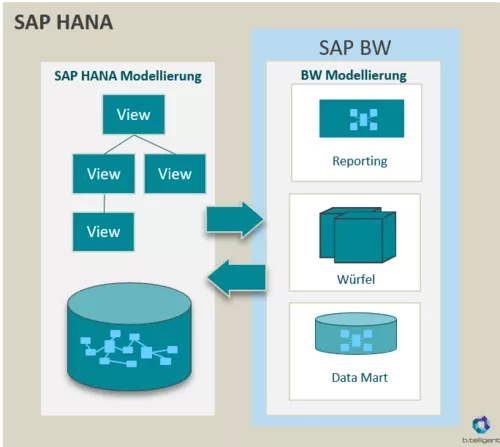In the scope of the use of a SAP Business Warehouse, past experience has shown that there have frequently been different approaches in companies that have led to the development of a parallel infrastructure. These tend to be managed by specific departments rather than IT. Solutions such as QlikView, SQL Server, Oracle and TM1 are widely used. These fulfil their tasks in the appropriate situation very well - otherwise they wouldn't be so popular.
The "Mixed Scenario" in detail
In retrospect, this can be seen as the intended purpose of SAP BW as a data warehouse, which "doesn't really support" certain adaptations. In most cases this is also an advantage: it means that on the one hand it is possible to prevent problems with the incorrect types of data and to ensure a consistent state of the data, while on the other hand it is also possible to monitor technically-relevant KPIs at a central location. With its "BW Workspaces" SAP took the first step to provide users with the freedom to upload data in SAP BW themselves, and to connect it with the existing data models. With the "Mixed Scenario" introduced under SAP BW on HANA, SAP has gone even further: here, the Enterprise Data Warehouse in the form of SAP BW is connected with a flexible SQL-oriented level which in many cases enables rapid response times, even with continuously changing departmental requirements.
The SAP BW does not become superfluous, however: rather, both scenarios complement each other with the best attributes from both worlds. An integration can also take place in both directions. Through external HANA views (views generated automatically by SAP BW), mutli-dimensional InfoCubes, queries or master data are made available at the native HANA level. Tables from HANA can be integrated directly in reports via Open ODS Views. In this respect, all of the key areas, such as permissions in SAP BW, are also taken into account.
Advantages of the implementation of SAP BW on HANA
The scenario described above has some key advantages. The data transfer which is required with the third party solution can frequently be omitted, for example, and the permissions can be reused in the key items at the same time. Despite the separation of both of the components, a close coordination has to take place, and in the BI Competence Center it is necessary to ensure that the development of a parallel DWH does not occur. This new flexibility can be managed on a similar basis to the report life cycles that we explained elsewhere Here, current self-service solutions are monitored which manage the requirements of the departments in terms of flexibility as well as the transfer to a standardisation. The requirements and IT processes are not disrupted by the separation in a specific tenant.
A technical overview of the possibilities is also available on the SAP blog.








